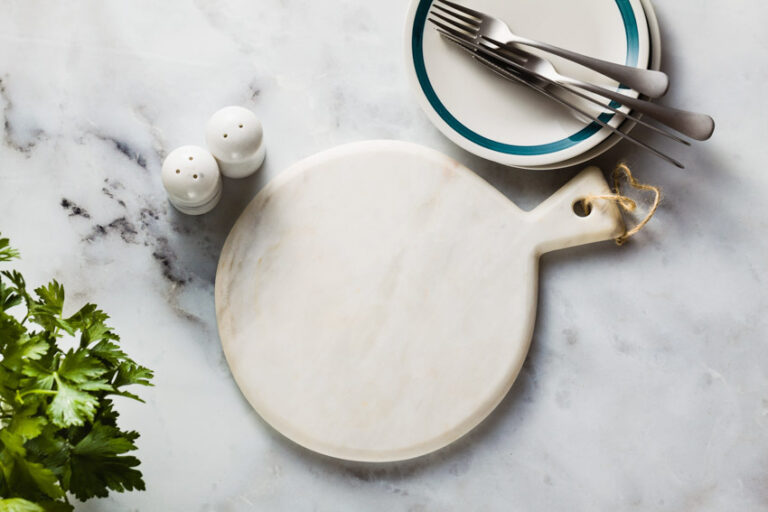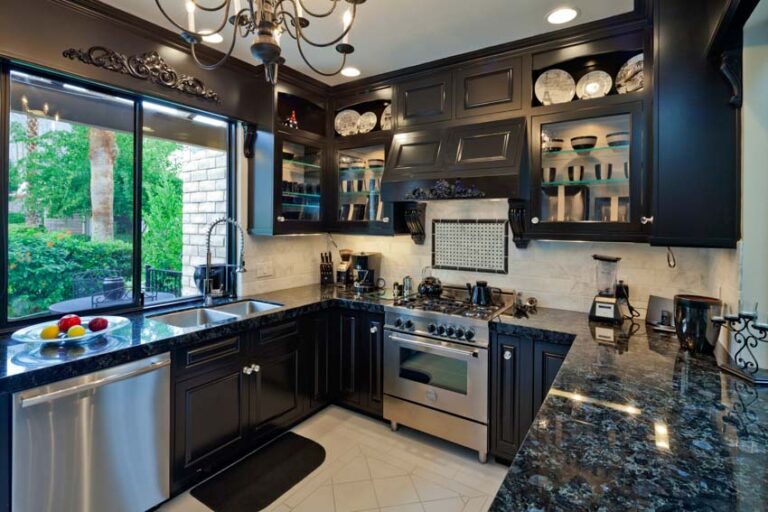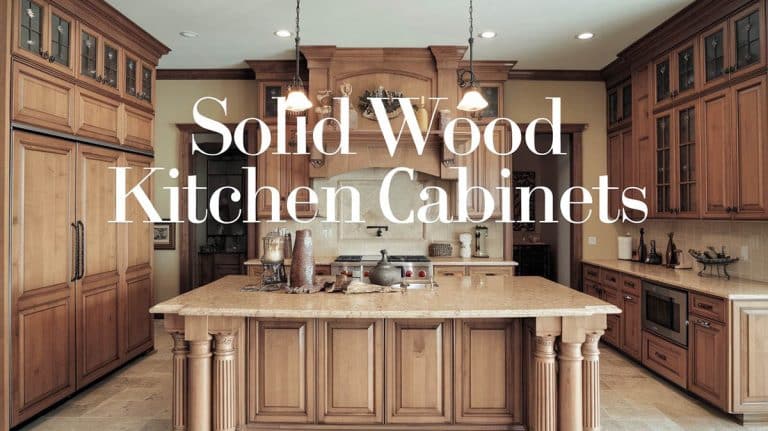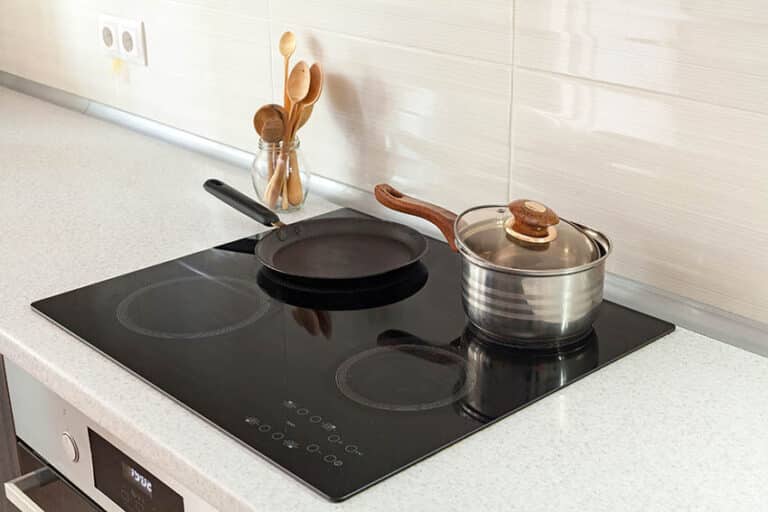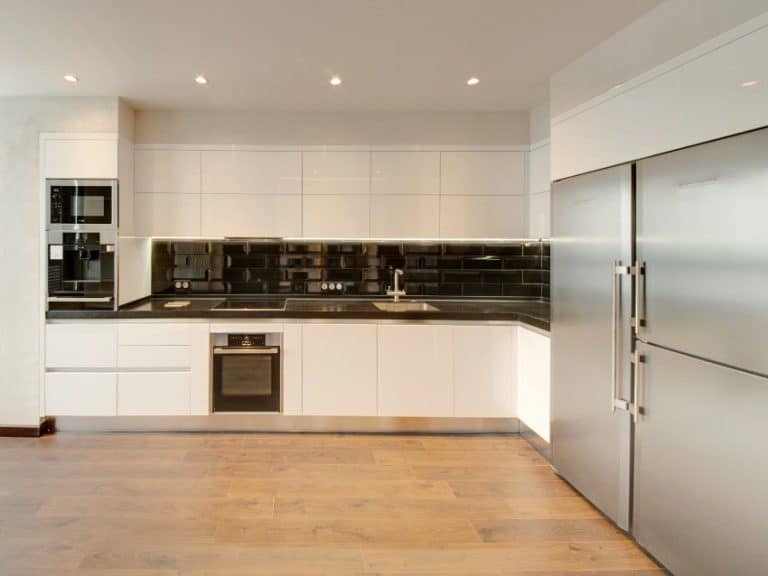10 Galley Kitchen Layout Ideas With Efficient Floor Plans
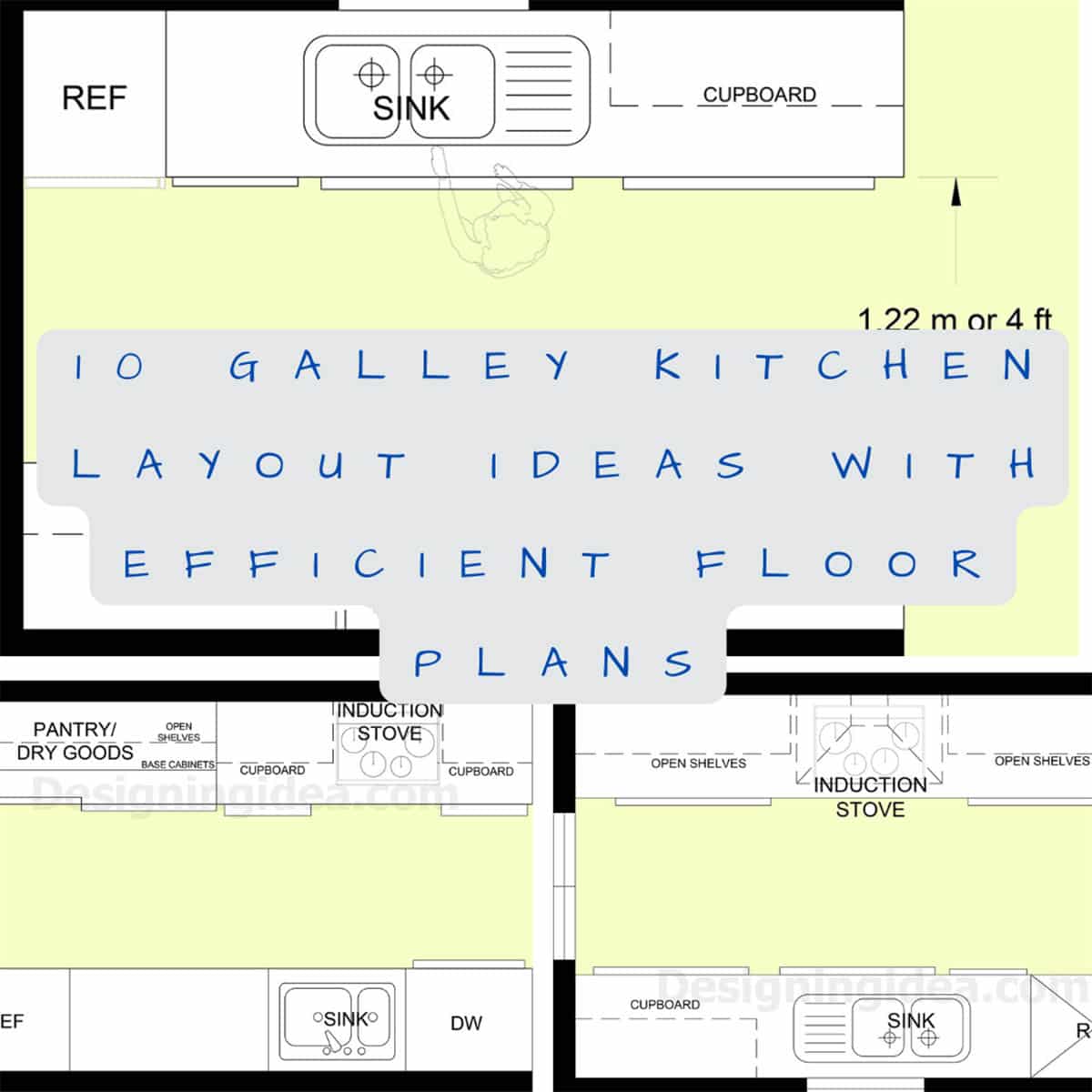
For the serious chef or the home buddy connoisseur, the galley kitchen is an excellent layout to utilize because of its practicality, efficiency, and adaptability. That is why building galley kitchens is not only confined to narrow and small spaces but can also be adopted to expansive spaces, creating dividers and defining boundaries.
Double-sided Galley
The double sided galley design offers two parallel countertops with appliances and cabinets on both sides. Ideal for larger spaces or open-plan layouts together with narrow and long spaces, for the reason many apartments use double-row galleys.
Also termed a double-row galley, the double-sided galley utilizes both sides of the row. It works well with kitchens that are long and can fit two countertops at minimum depths together with the recommended aisle width. The double-sided galley or parallel units are also a popular layout for commercial kitchens as they are divided into zones to work on different dishes.
Consider Dimensions:
- 1.22 m or 4 ft—the recommended distance between countertops since the average breadth of a person ranges from.470 to.5 m or 1.64 feet.
- 1 m or 42 inches—This can work for a single user for comfortable movement between the countertops.

Space Utilization: A pair of countertops are placed parallel to each other, leaving a middle aisle for circulation. The two rows can be symmetrical, which means the two rows have the same length, or asymmetrical; the other row may be longer or shorter than the other.
Tip: Don’t overwhelm the space with storage units. Instead, create a mixture of cabinets.
The layout shows the sink and refrigerator are assigned to one side while the cooking area is at the other countertop row. For double-row galleys, assigning the work triangle works well, especially if you have a wide aisle in between. This is also similar to open plans, as the second row is utilized as a seating area. Placing appliances on one side and counters or prep spaces on the other can help keep foot traffic streamlined.
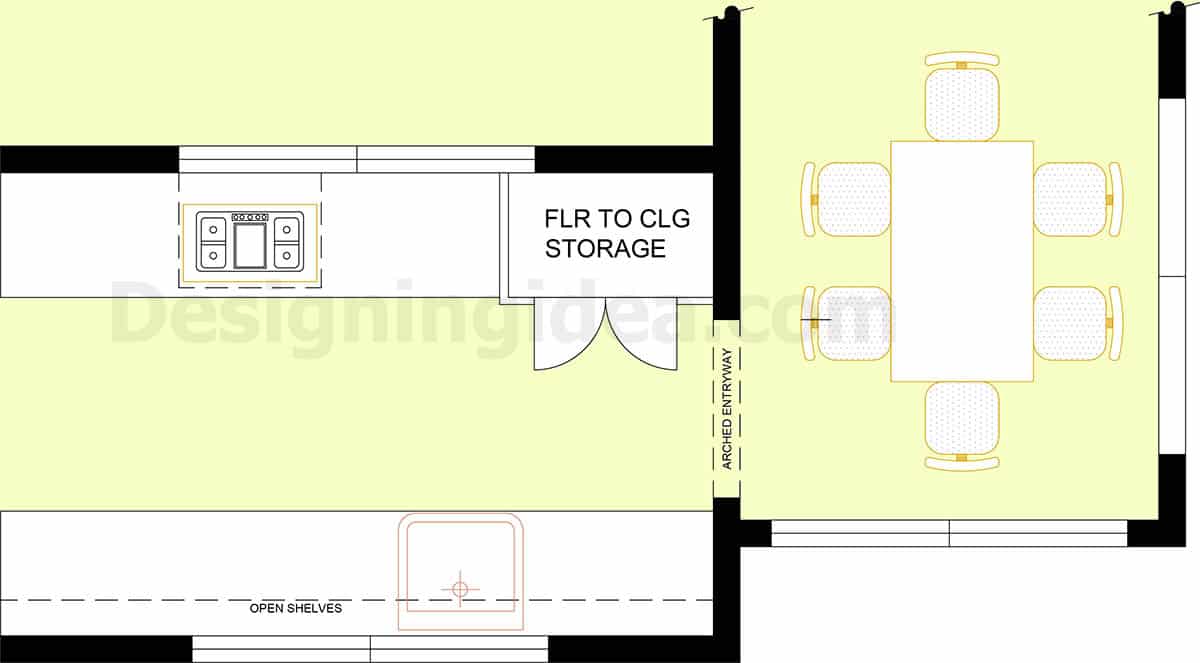
The narrow galley kitchen depicted above makes efficient use of its limited space thanks to a smart layout of dual countertops lining each wall, surrounding a central walkway. At the heart of the cooking area, a stovetop and oven unit stands ready to prepare meals. Surrounding counters provide meal prep space beside it.
Across lies the pièce de résistance: floor-to-ceiling cabinetry crammed with storage space for the well-equipped chef. Below, open shelves offer quick access to frequently used items so they’re close at hand. This purposeful placement of storage and prep areas minimizes movements between cooking and plating. An arched entryway links the kitchen seamlessly to the adjacent dining room—no need to squeeze through doorways while carrying hot dishes. With its workspace strung across compact yet functional stations, this floor plan is ideal for cooks who desire efficiency in a small space.
Single-sided galley
A common layout for small kitchens, the single-sided galley utilizes the single-row countertop accommodating the major functions. The layout is common in apartments and in most single-occupancy residences. Also termed a single-row galley kitchen or one-wall kitchen.
Consider Dimensions:
- 8 feet—recommended maximum length per work zone to ensure efficiency.
- 3 feet—minimum clearance between your single-row countertop and wall.
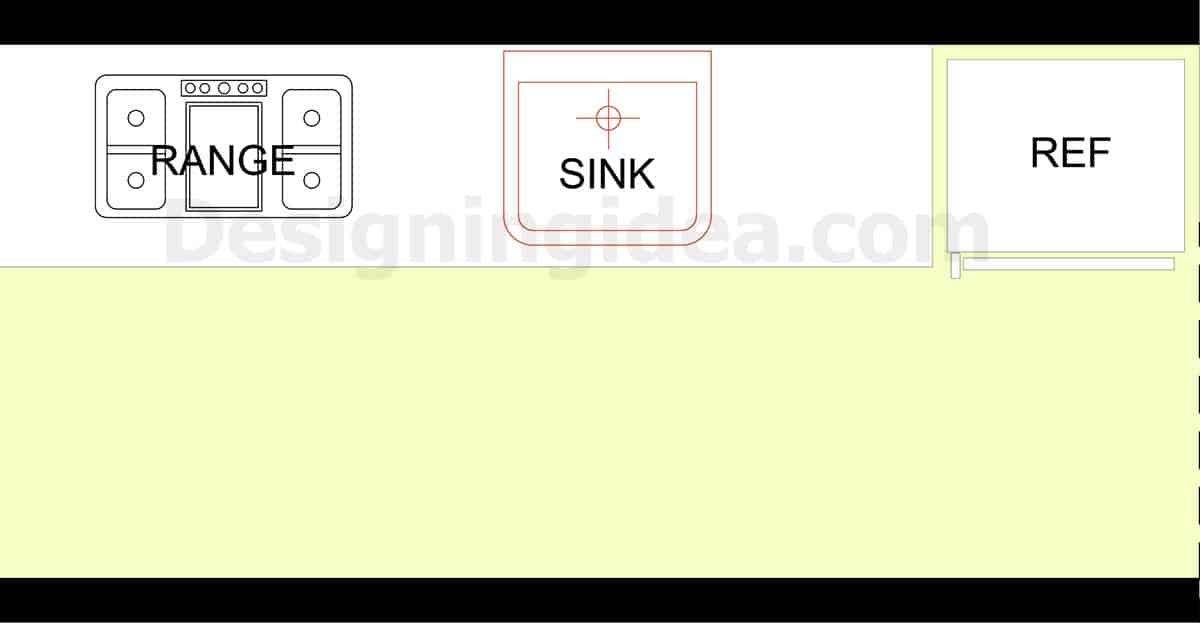
Space Utilization: To prevent the feeling of having a cramped area, leave at least one side open. Having connected or flowing spaces creates a feeling of having a larger space. Built-ins such as incorporating a full-height pantry will help declutter and keep the preparation surfaces of your single-row galley clear of items. A pull-out pantry in between your base cabinets can organize smaller items.
A single row of units without upper cabinets can look modern with its sleek look. Instead, assign a pantry area or cabinet near your countertop. Also, utilize the base cabinets as well and use tap or push-open hardware.
Tip: According to Melissa Klink of Harvey Jones, place your refrigerator away from windows as much as possible to maximize natural light and prevent too many users going into the work triangle.
Galley with Island
Adding an island along your single-row galley provides additional space for preparation, storage, or can double as an eating area.
You may also opt for a mobile island equipped with wheels for more versatile use.
Consider Dimensions:
- .9 to 1.2 m or 3 to 4 ft—recommended aisle space between island and countertop.
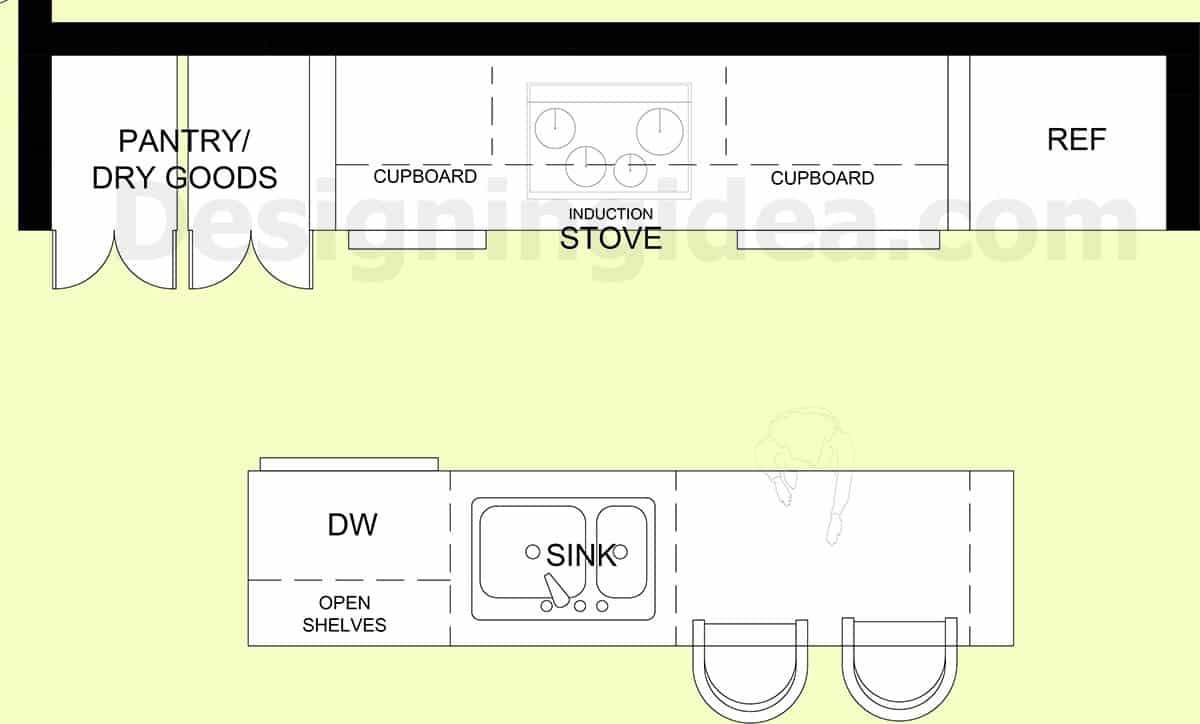
Space Utilization: The parallel kitchen island that is paired with your galley countertop is typically oriented along the center of the countertop, giving it a balanced and symmetrical look since most islands are shorter than your countertop. Although there is room for more asymmetrical or creative positioning, especially when addressing the ergonomic needs of users.
Tip: If you’re limited in countertop space, you can always opt for smaller fixtures, such as mini sinks, to make way for more preparation surfaces in your countertop. The mini sink is large enough to wash dishes but not as wide enough to pile up dishes.
You can also opt for a freestanding worktable if there’s not enough clearance for a full island counter.
L-shaped Galley
Extend one end of your galley counter to create an L-shaped layout. The added space can serve as a breakfast nook or added preparation space. Others use it as a highchair for toddlers or babies or a storage hub for books.
Consider Dimensions: According to Lamon Luther, the USA-based woodwork supplier, it is recommended to have at least 24 to 30 inches allocated for each diner. In addition, consider the space between each seat. A recommended 6 to 8 inches or.15 to.20 m spacing between chairs.
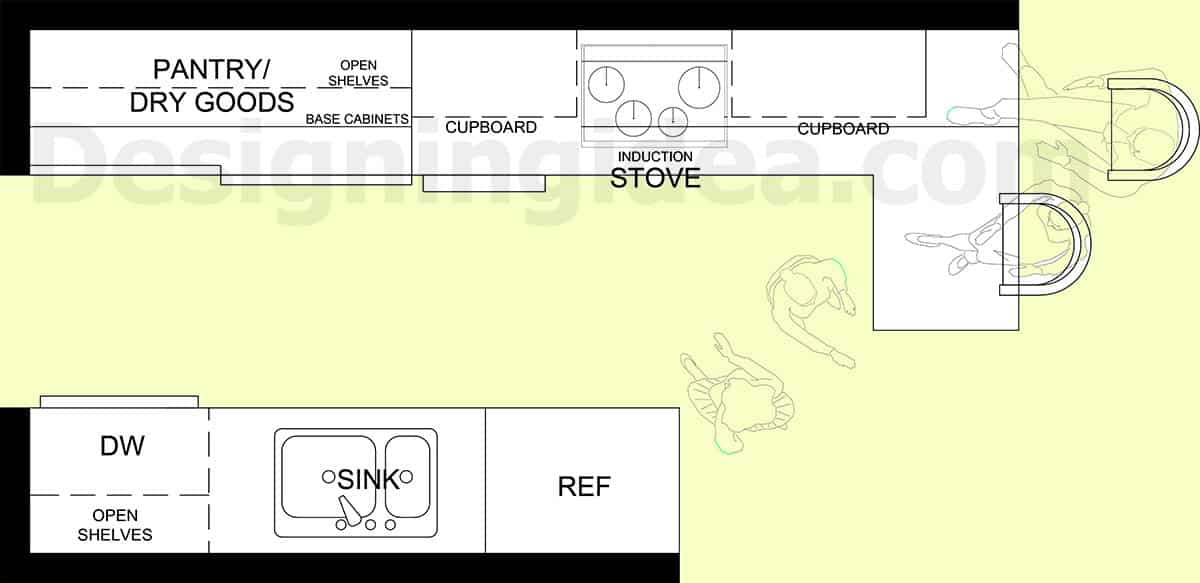
Space Utilization: Keeping in mind the recommended floor plan dimensions, also aim for a symmetrical layout with the extension to serve as offset from the parallel layout. This way, you balance dimensional elements with the modern or fixed layout.
Tip: Roger Higgins of R. Higgins Interiors hints on using reflective surfaces behind your work zones except, of course, your cooking areas to give that illusion of space.
Open-end Galley
Also termed a single open-end layout, the open-end gallery is mostly used on expansive interiors that have an open plan. This continuous flow encourages adjacent spaces to be inclusive and create that oneness of spaces with the help of other elements such as light and color.
Consider Dimensions: Because of the opened access, expect traffic flow to increase, so assign a wider aisle countertop with the recommended 24 inches of depth. For smaller spaces, 18 to 20 inches of depth are applicable.
- 36 to 48 inches—recommended clearance between appliances and adjacent room.
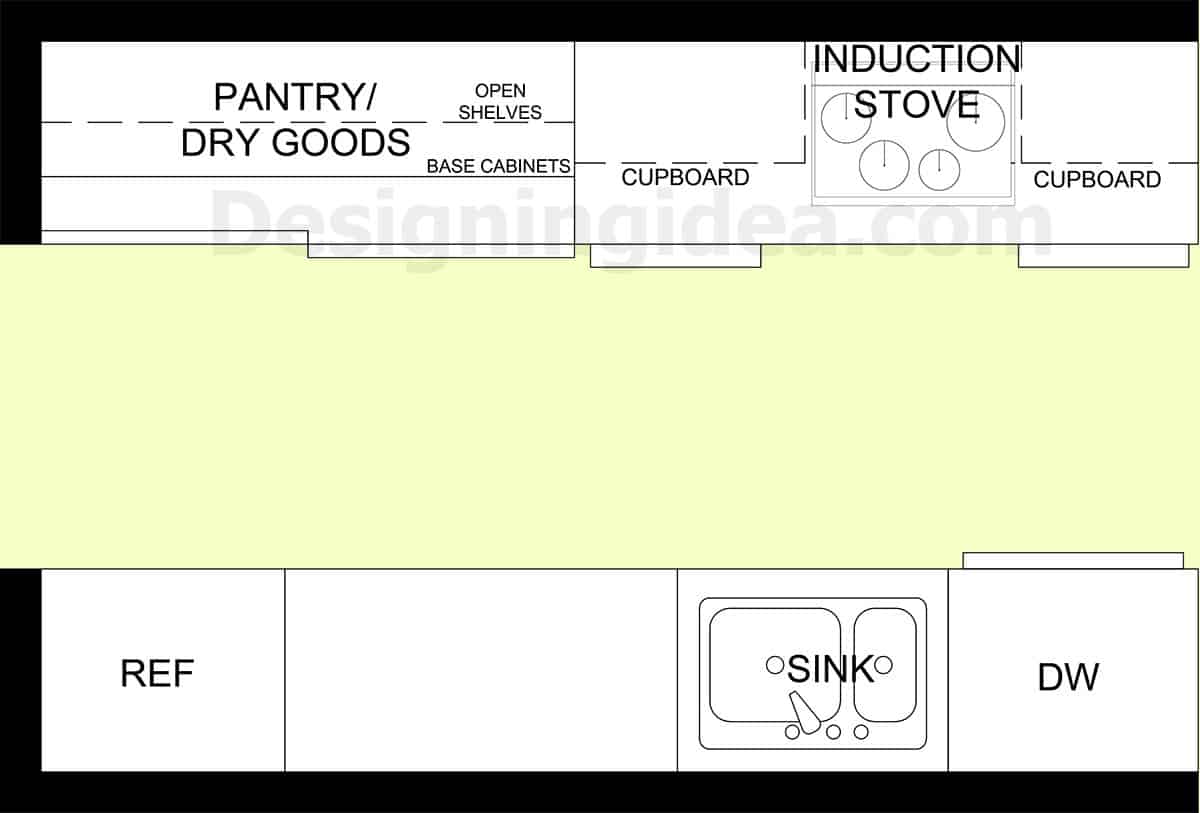
Space Utilization:
Make use of your open-end access by connecting the kitchen to adjacent rooms that are connected or are related to your functional area, such as the dining or living room, which are both social spaces.
A pass-through window instead of the full open-ended galley can add a level of privacy to your semi-public kitchen when connecting it to your living or dining room.
The open-end galley is also popular in extending its countertop surface to a peninsula or island to increase workspace. These extra countertop areas can also serve as dining or breakfast nooks.
Tip: Use visual cues such as subtle flooring transitions or lighting between the areas to mark areas. Meanwhile, you can use a similar color palette or materials to tie together the adjacent rooms to maintain that visual continuity.
Add style and visual interest in an open-end galley layout by spreading a runner down the aisle.
Zoned Galley
Assign areas for major functions such as cooking, preparation, and washing or cleaning. By zoning in work zones, you are able to optimize movement.
This is a classic kitchen layout and was proposed to provide a formula for efficiency. Though there are designers that find the guideline not applicable to all kitchen conditions.
Divide the kitchen into specific work zones (prep, cooking, cleaning). Enhances efficiency and workflow

Consider Dimensions:
12 and 26 feet—recommended total perimeter or the sum of the three sides from your work triangle. This rule of thumb determines that if you have a space less than 13 ft, the space can feel cramped. Meanwhile, a sum greater than 26 feet can equate to an inefficient layout due to the longer walking distance between areas.
Space Utilization: It is best to prevent any obstacles along the work triangle, such as cabinets or placing an island. Zoned galleys work well when the aisle is not used as a thoroughfare.
Tip: Avoid grouping workstations in one area so as not to make spots along the galley kitchen too crowded.
Galley with a View
Known as natural mood boosters, lighting and vistas can effortlessly transform a space and make it feel larger and more welcoming. Moreover, you get natural disinfectant when surfaces are exposed to UV lights where the growth of mold and mildew is minimized.
Consider Dimensions:
4 ft (width) x 3 ft (length)—your typical dimensions for a picture window that allows ample lighting. A range of 3 ft to 5 ft wide can be considered.
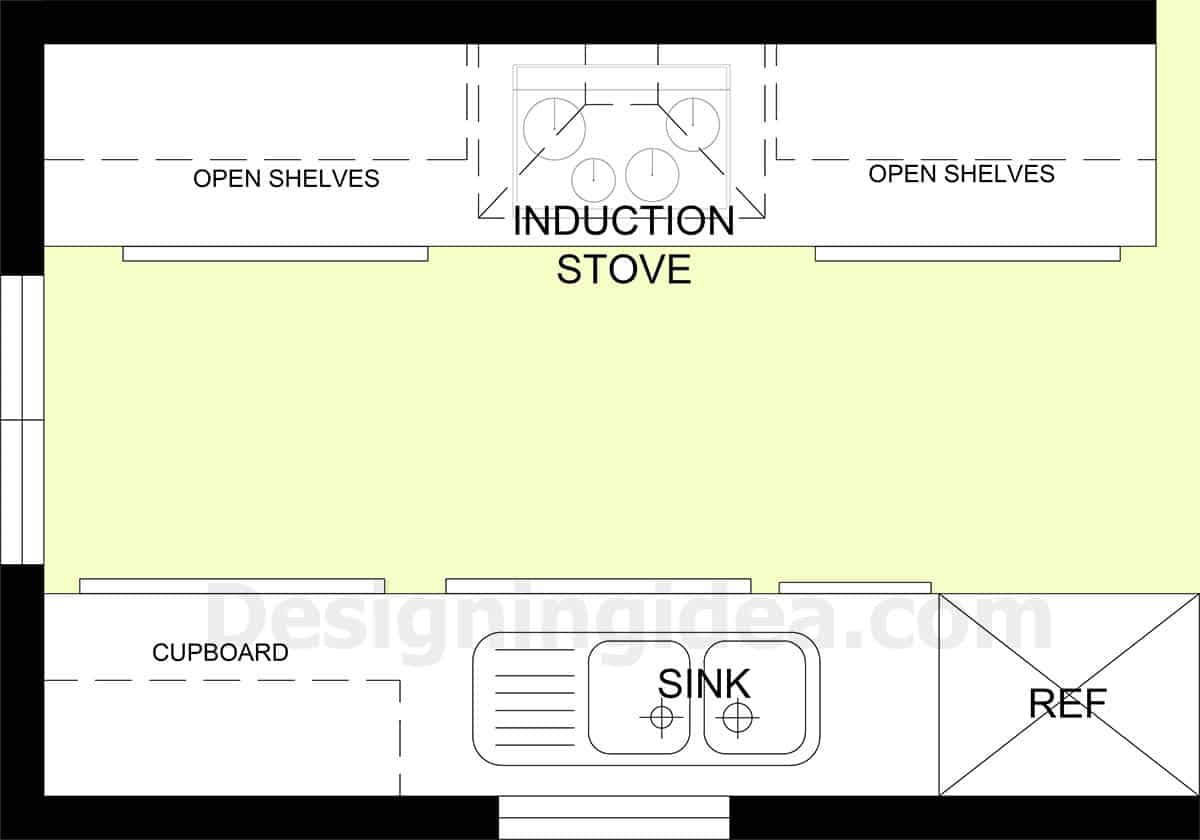
Space Utilization: Windows are an opportunity to add storage systems that are simple and that are constraint to the window. Add a wall rack along the lower part for additional storage.
Tip: If full windows are not possible, consider punching out smaller or micro windows between your shelving and the counter. If you have open shelving in more areas, you can add smaller windows for natural light and ventilation.
Vertical Storage Galley
When square footage is limited, create space by utilizing the vertical space extending to the fifth wall.
Consider Dimensions:
- 9 to 10 feet is the ideal ceiling height of a kitchen that can accommodate a floor-to-ceiling storage unit. These tall cabinets can store a variety of kitchen utensils and supplies with longer or larger sizes and are seldomly used.
- 84 to 64 inches—the typical height of floor to ceiling cabinets.
- 12 to 24 inches—the typical depth of storage cabinets with floor to ceiling height.
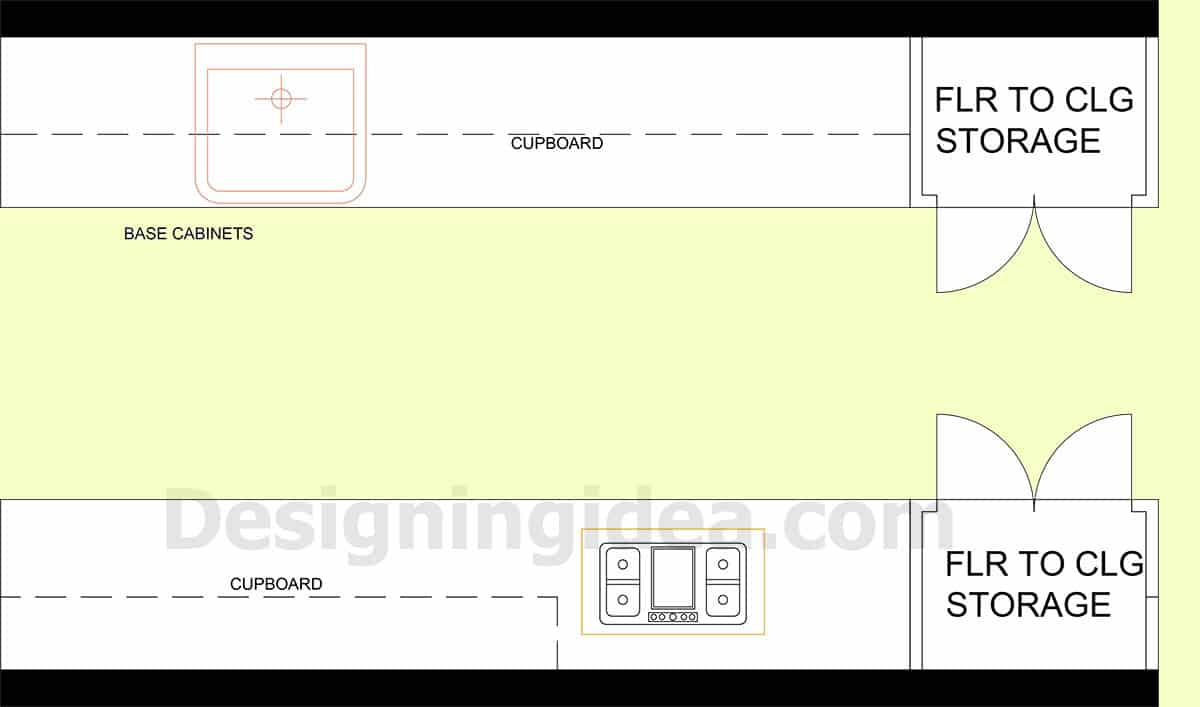
Space Utilization:
Pantry cabinet shelves are typically spaced from 12 to 16 inches apart; however, you can find adjustable shelves to further customize your storage needs.
When specifying your cabinets, aim for a balanced look and where key zones such as the sink or cooking area are not hovered over or congested with storage cabinets. Assign tall cabinets in one area or side to prevent the cramped look. A rule of thumb is to avoid placing cabinets at eye level.
Tip: To keep with the vertical use, you can extend your countertop material vertically to serve as a backsplash. This works well with countertops that are made from stone. The extended material can create a ledge on top of your backsplash where you can place additional items and serve as a ledge.
Pass-through Galley
The modern household is familiar with your dining, living, and kitchen combination as it showcases openness and minimalism. A pass-through galley kitchen is the perfect layout for such open plans where one end or both ends of your galley are accessible to another functional room.
Variations of the pass-through galley include full and partial pass-through. Partial pass-through is where upper cabinets or/and lower cabinets are intact, leaving a window-like access between the kitchen and functional space.
Consider Dimensions:
- 3 to 5 feet—typical width or opening between the galley kitchen and adjacent room with low traffic.
- 6 to 8 feet—the typical width or opening between galley kitchen and adjacent room with high traffic.
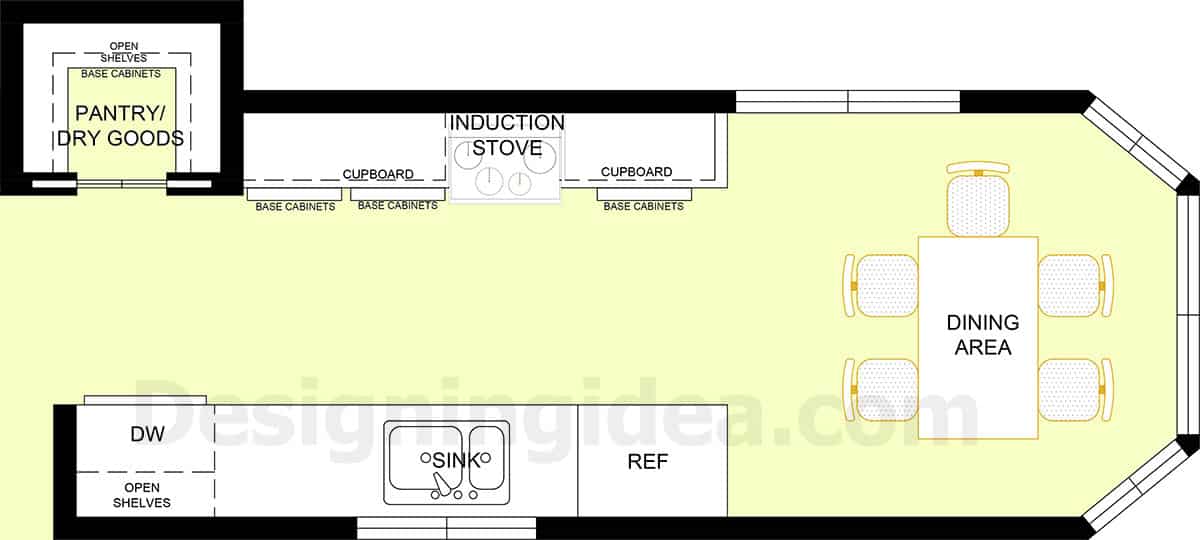
Space Utilization:
When both ends of your galley are open, then the amount of traffic passing through will mostly increase. Thus, the need for a wider opening than 3 feet.
When creating a pass-through access between functional rooms with an existing wall divider, it is best to consult a professional to make sure the structural integrity of your home remains intact. Utilities such as cable, internet, or electric may also run through the dividing wall and will need a professional to determine, remove, and relocate your wiring.
Tip: If you have existing walls or door egress between functional spaces, you can opt to remove the door and replace it instead with an archway instead.
If you’re not interested in opening your wall entirely to the adjacent room, you can consider replacing your wall instead with a rolling or movable counter. You simply move away the counter when you want to go out and roll it in when closing off the area.
Asymmetrical Galley
Aside from visual interest, an asymmetrical floor plan may be the best kitchen layout for rooms with spatial constraints. These limitations can be worked around through the asymmetrical floor plan, allowing utilization of available space.
The layout is characterized by having parallel countertops but having different lengths. Also, there are variations of asymmetrical galley layouts that have different depths, heights, and cabinetry designs, which contribute to eye-catching aesthetics.
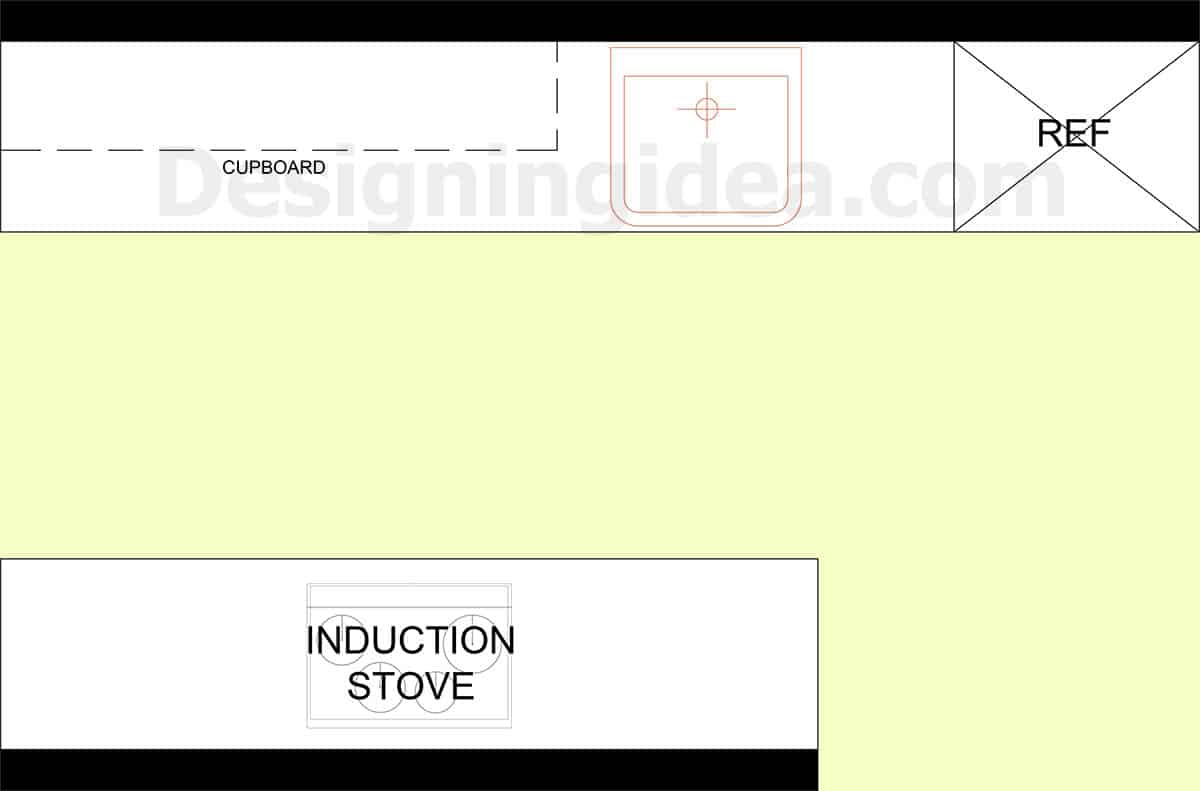
Consider Dimensions:
42 to 48 inches—recommended clearance between kitchen elements and furniture from the adjacent room.
36 inches—minimum distance between dining table and adjacent kitchen furniture.
Space Utilization:
The asymmetrical kitchen allows better workflow due to customization against specific needs as well as placing busy areas in strategic locations while leaving room for negative spaces.
Use different depths or heights on each side. Can add visual interest and accommodate specific appliances.
Tip:
Adjust measurements, even standard ones, when opting for furniture or built that is customized to your specific body measurements. For instance, the recommended countertop surface height is 30 inches or 76.2 cm for baking activities; the standard height, meanwhile, is 36 inches or 91.4 cm. Bar counter height is higher than your standard height, which usually is 42 inches or 106.7 cm. Check out our 10ft galley style kitchen layouts here for more ideas.

